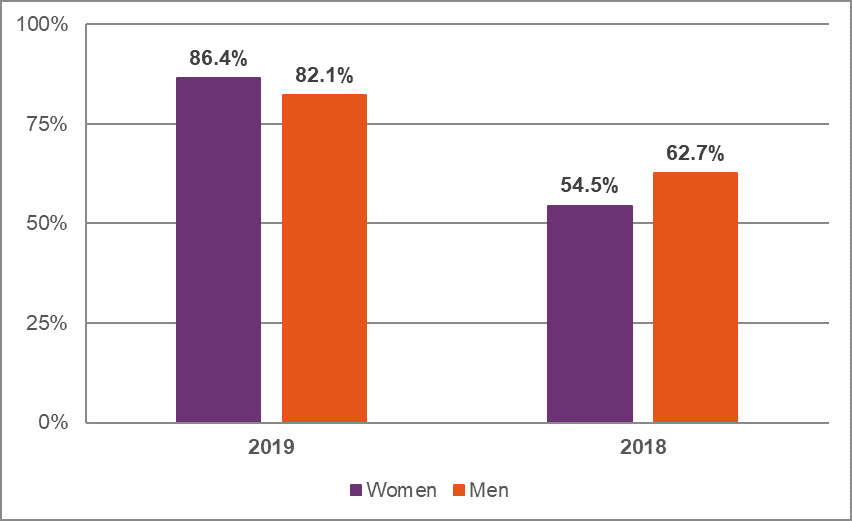Since April 2017, employers with 250 or more colleagues have been required by law to publish the pay gap between men and women.
The gender pay gap is the difference between the average earnings of all the men and women working in an organisation, irrespective of their role or seniority. As such, it provides a broad indication of how well organisations are seeking to achieve gender equality.
Gender pay is distinct from equal pay, which is the legal requirement that men and women in the same employment performing equal work must receive equal pay. We are confident that we have equal pay.
In line with the gender pay gap legislation, the pay gap and pay quartiles information is based on payments made through payroll in April 2019. The bonus information reflects payments received during the 12 months from 6th April 2018 to 5th April 2019.
The gender pay gap shows the differences between the means (in other words, the average), and the medians (which are the mid-points) of pay and bonus earnings of male and female colleagues, expressed as a percentage of male colleague’s earnings.
Pay gap
The
following table summarises our gender pay gap based on the April 2019 payroll
for 1,292 relevant colleagues within the charity.
For
comparison, we have included the average figures for the UK and for those
organisations classified as providing the same type of economic activity as
StepChange (Financial intermediation). Note that the UK and sector equivalent
figures for 2019 are not yet available; we'll update this page when they're published.
| In comparison to men
|
April 2019
|
April 2018
|
|
 women's mean hourly rate is women's mean hourly rate is
|
9.8% lower
|
8.3% lower
(UK average 14.2%, Financial Intermediation average 27.1% lower)
|
 women's median hourly rate is women's median hourly rate is
|
0.7% lower
|
0.6% lower
(UK average 11.9% lower, Financial Intermediation average 23.9% lower)
|
Our pay gap continues to be smaller than most other organisations and significantly below those with a similar focus.
Our median pay is almost equal for men and women, and the median pay gap has remained broadly unchanged.
The small gaps in mean and median pay are due to the proportion of men and women in the highest pay quartile, documented in the following section. The proportion of women in technical IT roles that attract higher salaries has reduced for 2019, resulting in a small increase in both the mean and median figures compared with 2018.
We also believe that this year’s small increases reflect the natural variations resulting from running the charity. The gender pay calculation is a snapshot of pay at a point in time and ongoing recruitment activity will see the gender pay gap fluctuate, both up and down, over time.
Pay quartiles
Overall, of the 1,292 colleagues included in this analysis, 53% are female and 47% are male. This represents a reasonably balanced population and reflects the UK’s overall gender split (51% female and 49% male).
As in previous years, the proportion of women is higher in all quartiles except the highest quartile where the proportion of men is 58%.
We recognise that technical and more senior roles within the charity are more likely to require STEM (science, technology, engineering and mathematics) qualifications and experience and that these, in turn, attract higher salaries. With fewer women than men graduating in STEM subjects this creates a less diverse candidate pool for us to recruit for these roles.
Bonus gap
All colleagues, except executive directors, were eligible for an annual bonus during 2019 if they met pre-defined criteria. The annual bonus for the year 2019 was paid to all eligible colleagues who had completed their probation period before the end of 2018.
In addition, 29 colleagues received a one-off bonus payment to aid colleague retention, or to recognise the role they played in the charity’s General Data Protection Regulation readiness activities.
Our bonus gap for the 12 months ending April 2019 is set out in the following table. We have also included the figures with the one-off bonuses removed, as this is a better representation of the charity as a whole. For comparison, we have included the average figures for the UK and for those organisations classified as providing the same type of economic activity as StepChange (Financial intermediation). Note that the UK and sector equivalent figures for 2019 are not yet available; we will update this page when they are published.
| In comparison to men
|
to April 2019
|
to April 2018
|
|
 women's mean bonus pay is women's mean bonus pay is
|
24.0% lower
3.2% lower with one-off
bonuses removed
|
9.5% lower
UK average 15.4%
lower
Financial intermediation average 52.8% lower
|
 women's median bonus pay is women's median bonus pay is
|
0.0% equal
0.0% equal with one-off
bonuses removed
|
17.3% lower
UK average 0.9%
higher
Financial intermediation average 42.8% lower
|
Our
median gap in bonus payments between men and women has reduced to zero, while
the mean gap has grown since 2018.
The zero median bonus gap is a consequence of all eligible colleagues receiving the same annual bonus value, with no pro-rating.
The mean bonus gap is a result of the majority of the one-off retention or GDPR bonuses being paid to men. While the criteria for receiving these bonuses was not gender-specific and was based on aiding colleague retention or recognising the role colleagues in making the charity GDPR-compliant, the outcome was that 18 of the 29 payments were paid to men. If these one-off payments are removed, the mean gap falls to 3.2% and the median gap is unchanged at zero. The remaining mean gap is driven by the higher bonus payments for members of the Senior Leadership Team; a small majority of whom are male.
For 2020 we have introduced pro-rating, based on colleague service and working hours, for the annual bonus. This, in conjunction with the lack of one-off payments, should result in a lower bonus gap for both mean and median for 2020.
Proportion of colleagues receiving a bonus
More
of our colleagues received a bonus during the year to April 2019 than in either
of the previous two years. There is still a gap regarding the proportion of men
and women who received a bonus but, for the first time, this now favours women:

The difference between the proportions of men and women receiving a bonus is a result of the annual bonus eligibility criteria; the annual bonus was paid to all eligible colleagues who had completed their probation period before the end of 2018 and a greater proportion of women than men were eligible.
Read the previous year's report